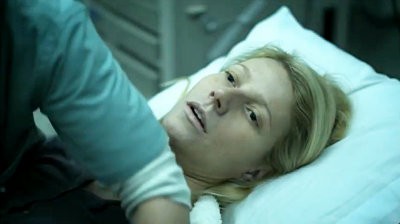
Still from Pina, 2011, Wim Wenders
Like anyone with an interest in movies, I've seen my consumption evolve from repertory houses, to indie chains, to the current streaming standard. Now I am entertained and edified by amazing libraries of material instantaneously available to cater to whatever whim or interest. (I've even stuck with Netflix despite their gaffes.)
Access is a wonderful thing, and yet, I miss movie theaters. Architecture adds to focus, as does the effort and cash investment required to be more immersed in a vision, and the possibility of having a more shared experience. Anthony Lane writes in the New Yorker about Lars Von Trier's Melancholia from the standpoint of its availability -- it bizarrely was a video on demand of before it was in theaters. Lane offers that home cinema is an oxymoron. "We are strangers in communion, and, once that pact of the intimate and the populous is snapped, the charm is gone," he laments.

Gwyneth Paltrow in Contagion, 2011, Steven Soderbergh
I don't think I'm waxing nostalgic to admit I break for the spectacle of film, for scale and formats that offer something extra. I made a point to see Contagion, the IMAX Experience version, though I balked at $18 admission fee. Apparently Steven Soderbergh loves the grand scale of the projected image and used this as an opportunity to expand his medium and sink into it more deeply. I got a thrill viewing Gwyneth Paltrow's imposing death pallor because it was an amazingly composed and shot image that, at fifty-foot scale, makes you wonder about artifice, acting (isn't she brave to let us see every pore?) and the enormity of a subject. This format is the antithesis of laptop theater, but so is Contagion, more a visually sleek globe trotting thriller than a dour health policy science doc that you wouldn't mind watching on a your iPhone.

In the last week, I twice got myself to theaters to see new 3D films -- Pina, Wim Wenders' remarkable dance film for the late German choreographer Pina Bausch, and A Very Harold & Kumar 3D Christmas the gleeful stoner sequel directed by little known Todd Strauss-Schulson. They couldn't be more different -- I relish getting them into the same paragraph -- but both were highly satisfying film experiences. The latter milks visual gags, like blowing giant pot smoke rings and hurling raw eggs at the audience, while the former thrillingly translated theatricality of dance to cinematic space. Both make cases for their format that go beyond gimmickry and pumped up ticket prices.
H&K relishes visual possibilities over plot points, which are stoner stupid, and self-consciously admits its aspirations -- there are jabs at 3D hi def flat screen TVs and James Cameron's pioneering title is termed "Avatarded." The film, rooted in B-movie humbleness, wholeheartedly embraces the irresistible 3D funhouse appeal of claymation, randy Busby Berkeley-style dance numbers, slow motion beer pong, cocaine clouds, and sundry projectiles. The film gets away with it by delivering eye candy by the handful, and we're not talking artisanal chocolates.


Stills from Pina, 2011, Wim Wenders
Wenders' film definitely comes from a gourmet kitchen (I saw it in a film festival context), but it's a richer, more transcendent cinematic experience, a particularly effective merger of media. Originally conceived as a collaboration between the filmmaker and choreographer, Bausch died before the project was fully conceived. The film's concept and appearance is driven by its use of improved 3D technology, which seems to have become more nimble, as well as the artful genius of the material. While Pina includes testimonials from dancers from the ensemble (which will be touring the US this winter) about their choreographer, this is not a documentary. It's an expansion of the original works. Wenders wisely opens the frame to take the choreography -- by turns witty, sexy, sad and ebullient -- into locations beyond the stage. Dances occur in quarries, factory grounds, sleek modernist architecture, well-trafficked urban streets, and monorail cars in the German city of Wuppertal where the company has been based for decades. It also honors the beauty of the figure, as Wenders, who demonstrated visual panache in his classics like Wings of Desire, creates formally filmed portraits of each of the dancers in sequences that bring to mind Andy Warhol's Screen Tests. (It should be noted that Warhol also lent his name to a 3D Frankenstein in 1973).
Like H&K, Pina includes 3D clichés that are probably difficult for anyone to resist. In one scene, a woman in a peignoir (a recurrent Bausch costume) ebulliently lets loose with a leaf blower on a autumn hillside casting golden foliage seemingly out into the theater, in another sequence, a shirtless man balances tree branches on his arms and shoulders and walks towards the camera. Both films manage to present perfectly convincing reasons to use 3D, and to get us back into theaters to experience joy. H&K is in wide release, but if nothing else, this blog is to thank Sundance Selects, which has U.S. distribution, for getting this amazing film into cinemas this winter. I'm ready to see it again (and again).
This post has been modified since its original publication.